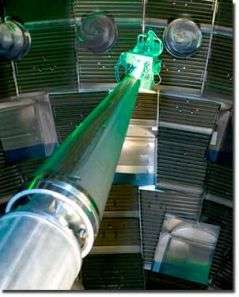World’s largest laser picks up the pace

With their target completion date just a year and a half away, scientists and technicians at the National Ignition Facility (NIF) are quickening their pace to install and test the rest of NIF’s 192 lasers and prepare for a new round of preliminary experiments in 2008.
Ninety-six NIF beamlines have been fired together for the first time, with “excellent” control system and laser stability, according to NIF & Photon Science Principal Associate Director Ed Moses. Last month the facility’s injection laser systems, which initiate the laser pulses, were fired for 144 beamlines.
“A total infrared energy of more than 2.5 megajoules has now been fired,” Moses said. “This is more than 40 times what the Nova laser (NIF’s predecessor) typically operated at the time it was the world's largest laser.”
Tests and sophisticated computer simulations confirm that NIF, under construction at Lawrence Livermore National Laboratory in northern California, is well on the way to reaching its design specification of 1.8 million joules of ultraviolet energy when all beamlines are completed in 2009 (NIF’s infrared laser energy is converted to ultraviolet for laser fusion experiments to minimize energy loss.)
The first of the facility’s two 96-beam laser bays was commissioned at the end of July. Each of the 96 beams fired an infrared output energy of about 22,000 joules, more than enough to meet NIF’s operational and performance requirements. Since then six more eight-beam “bundles” are being commissioned in the second laser bay, and three of these bundles have been operationally qualified.
“This is a significant event as we move towards completion of the National Ignition Facility,” said Thomas D'Agostino, administrator of the National Nuclear Security Administration (NNSA). “The day is coming soon when we will be able to simulate the conditions of extreme temperature and pressure approaching those existing in nuclear explosions.”
Overall commissioning of the NIF beamlines is scheduled for 2009.
The laser shots last about 25 billionths of a second, a tiny fraction of the time it takes to blink an eye. Firing the beams requires operation of 2,300 high-quality optics and instrumentation modules and nearly 400 computers running a million lines of control system code.
The tests measure the quality of each beam’s spatial profile and temporal pulse shape. Even though each shot is exceedingly short in time, its energy output and frequency is designed to vary significantly throughout its duration depending on the type of experiments being conducted.
Chris Haynam, the physicist responsible for modeling and testing the quality and performance of the lasers, pointed out that only about a dozen people on NIF’s overnight “owl” shift participated in the control room activities marking completion of commissioning activities for the first laser bay.
“This is a good thing,” said Haynam. “In fact, physicists and chief engineers do not have to be there. The details were worked out far ahead of time. We gave them the plan. The operators executed the plan per the schedule. And it went off without a hitch.”
Meanwhile, data gathered from experiments conducted at NIF in 2003-2004 have enabled sophisticated computer simulations that confirm NIF’s ability to reach the energy levels and beam quality required to produce the world’s first demonstration of inertial confinement fusion.
The “NIF Early Light” experiments included four shots using four laser beams at high energy on a full-scale target for the first time. Simulations of the experiments on LLNL’s world-class supercomputers matched the actual experimental data to an unprecedented degree. The experiments and simulations indicate that NIF’s laser beams will propagate effectively in plasma-filled targets designed to achieve fusion ignition and thermonuclear burn.
When NIF is operating, the infrared energy from its 192 laser beams will be converted to 1.8 million joules of ultraviolet energy and delivered to millimeter-sized targets at the center of its target chamber in a pulse lasting about ten nanoseconds (billionths of a second). This is equivalent to 1,000 times the electrical generating power of the United States in the same brief time period.
The laser beams will compress a hollow shell filled with the hydrogen isotopes deuterium and tritium to up to 100 times the density of lead. In the resulting conditions – temperatures of more than 100 million degrees Celsius and pressures as much as 100 billion times the Earth's atmosphere – the fuel core will ignite and thermonuclear burn will quickly spread through the compressed fuel, releasing many times more energy than the amount deposited by the laser beams.
Inertial confinement fusion experiments at NIF will create conditions similar to those inside an exploding thermonuclear weapon or in the cores of stars and giant planets. The resulting information will be used to help insure the reliability and safety of the nation’s nuclear stockpile without underground testing. The data also will reveal new details about the nature and structure of the universe.
NIF experiments next year will focus 96 beams on a gold hohlraum (the eraser-sized capsule containing the fusion target) filled with a light gas mixture. Dubbed “Eos” for the Greek goddess of dawn, the experiments will use the first set of beams from the completed laser bay, traveling to the center of the ten-meter diameter target chamber. They are designed to help validate key aspects of the full-scale ignition campaign that begins in 2010.
Source: Lawrence Livermore National Laboratory





















